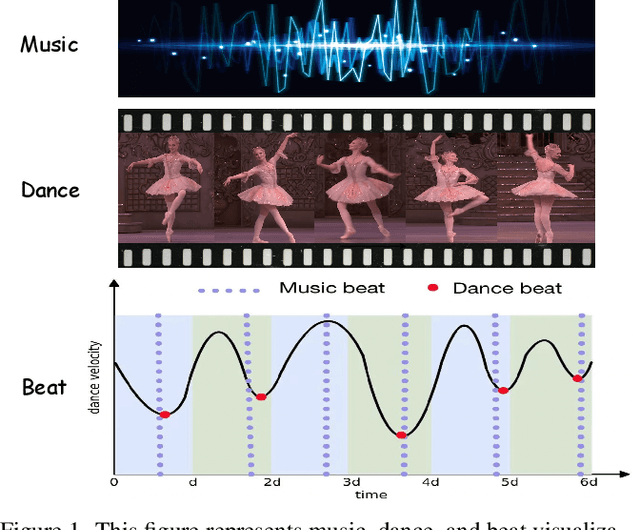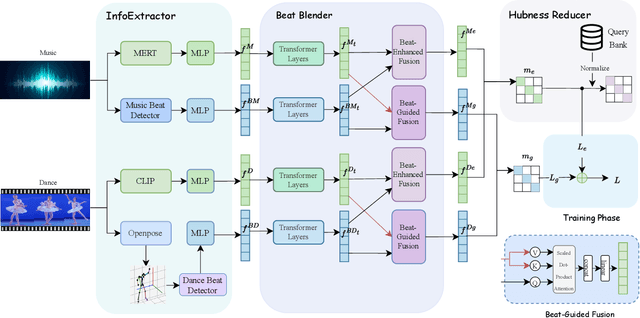Kaixing Yang
MEGADance: Mixture-of-Experts Architecture for Genre-Aware 3D Dance Generation
May 23, 2025Abstract:Music-driven 3D dance generation has attracted increasing attention in recent years, with promising applications in choreography, virtual reality, and creative content creation. Previous research has generated promising realistic dance movement from audio signals. However, traditional methods underutilize genre conditioning, often treating it as auxiliary modifiers rather than core semantic drivers. This oversight compromises music-motion synchronization and disrupts dance genre continuity, particularly during complex rhythmic transitions, thereby leading to visually unsatisfactory effects. To address the challenge, we propose MEGADance, a novel architecture for music-driven 3D dance generation. By decoupling choreographic consistency into dance generality and genre specificity, MEGADance demonstrates significant dance quality and strong genre controllability. It consists of two stages: (1) High-Fidelity Dance Quantization Stage (HFDQ), which encodes dance motions into a latent representation by Finite Scalar Quantization (FSQ) and reconstructs them with kinematic-dynamic constraints, and (2) Genre-Aware Dance Generation Stage (GADG), which maps music into the latent representation by synergistic utilization of Mixture-of-Experts (MoE) mechanism with Mamba-Transformer hybrid backbone. Extensive experiments on the FineDance and AIST++ dataset demonstrate the state-of-the-art performance of MEGADance both qualitatively and quantitatively. Code will be released upon acceptance.
MatchDance: Collaborative Mamba-Transformer Architecture Matching for High-Quality 3D Dance Synthesis
May 21, 2025Abstract:Music-to-dance generation represents a challenging yet pivotal task at the intersection of choreography, virtual reality, and creative content generation. Despite its significance, existing methods face substantial limitation in achieving choreographic consistency. To address the challenge, we propose MatchDance, a novel framework for music-to-dance generation that constructs a latent representation to enhance choreographic consistency. MatchDance employs a two-stage design: (1) a Kinematic-Dynamic-based Quantization Stage (KDQS), which encodes dance motions into a latent representation by Finite Scalar Quantization (FSQ) with kinematic-dynamic constraints and reconstructs them with high fidelity, and (2) a Hybrid Music-to-Dance Generation Stage(HMDGS), which uses a Mamba-Transformer hybrid architecture to map music into the latent representation, followed by the KDQS decoder to generate 3D dance motions. Additionally, a music-dance retrieval framework and comprehensive metrics are introduced for evaluation. Extensive experiments on the FineDance dataset demonstrate state-of-the-art performance. Code will be released upon acceptance.
CoheDancers: Enhancing Interactive Group Dance Generation through Music-Driven Coherence Decomposition
Dec 26, 2024



Abstract:Dance generation is crucial and challenging, particularly in domains like dance performance and virtual gaming. In the current body of literature, most methodologies focus on Solo Music2Dance. While there are efforts directed towards Group Music2Dance, these often suffer from a lack of coherence, resulting in aesthetically poor dance performances. Thus, we introduce CoheDancers, a novel framework for Music-Driven Interactive Group Dance Generation. CoheDancers aims to enhance group dance generation coherence by decomposing it into three key aspects: synchronization, naturalness, and fluidity. Correspondingly, we develop a Cycle Consistency based Dance Synchronization strategy to foster music-dance correspondences, an Auto-Regressive-based Exposure Bias Correction strategy to enhance the fluidity of the generated dances, and an Adversarial Training Strategy to augment the naturalness of the group dance output. Collectively, these strategies enable CohdeDancers to produce highly coherent group dances with superior quality. Furthermore, to establish better benchmarks for Group Music2Dance, we construct the most diverse and comprehensive open-source dataset to date, I-Dancers, featuring rich dancer interactions, and create comprehensive evaluation metrics. Experimental evaluations on I-Dancers and other extant datasets substantiate that CoheDancers achieves unprecedented state-of-the-art performance. Code will be released.
BeatDance: A Beat-Based Model-Agnostic Contrastive Learning Framework for Music-Dance Retrieval
Oct 16, 2023



Abstract:Dance and music are closely related forms of expression, with mutual retrieval between dance videos and music being a fundamental task in various fields like education, art, and sports. However, existing methods often suffer from unnatural generation effects or fail to fully explore the correlation between music and dance. To overcome these challenges, we propose BeatDance, a novel beat-based model-agnostic contrastive learning framework. BeatDance incorporates a Beat-Aware Music-Dance InfoExtractor, a Trans-Temporal Beat Blender, and a Beat-Enhanced Hubness Reducer to improve dance-music retrieval performance by utilizing the alignment between music beats and dance movements. We also introduce the Music-Dance (MD) dataset, a large-scale collection of over 10,000 music-dance video pairs for training and testing. Experimental results on the MD dataset demonstrate the superiority of our method over existing baselines, achieving state-of-the-art performance. The code and dataset will be made public available upon acceptance.
SHLE: Devices Tracking and Depth Filtering for Stereo-based Height Limit Estimation
Dec 22, 2022



Abstract:Recently, over-height vehicle strike frequently occurs, causing great economic cost and serious safety problems. Hence, an alert system which can accurately discover any possible height limiting devices in advance is necessary to be employed in modern large or medium sized cars, such as touring cars. Detecting and estimating the height limiting devices act as the key point of a successful height limit alert system. Though there are some works research height limit estimation, existing methods are either too computational expensive or not accurate enough. In this paper, we propose a novel stereo-based pipeline named SHLE for height limit estimation. Our SHLE pipeline consists of two stages. In stage 1, a novel devices detection and tracking scheme is introduced, which accurately locate the height limit devices in the left or right image. Then, in stage 2, the depth is temporally measured, extracted and filtered to calculate the height limit device. To benchmark the height limit estimation task, we build a large-scale dataset named "Disparity Height", where stereo images, pre-computed disparities and ground-truth height limit annotations are provided. We conducted extensive experiments on "Disparity Height" and the results show that SHLE achieves an average error below than 10cm though the car is 70m away from the devices. Our method also outperforms all compared baselines and achieves state-of-the-art performance. Code is available at https://github.com/Yang-Kaixing/SHLE.
 Add to Chrome
Add to Chrome Add to Firefox
Add to Firefox Add to Edge
Add to Edge